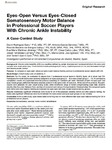Mostrar o rexistro simple do ítem
Eyes-Open Versus Eyes-Closed Somatosensory Motor Balance in Professional Soccer Players With Chronic Ankle Instability: A Case-Control Study
| dc.contributor.author | López-López, Daniel | |
| dc.contributor.author | Rodríguez Sanz, David | |
| dc.contributor.author | García-Sánchez, Antonio | |
| dc.contributor.author | Becerro-de-Bengoa-Vallejo, Ricardo | |
| dc.contributor.author | Martínez-Jiménez, Eva María | |
| dc.contributor.author | Fernández-Carnero, Josué | |
| dc.contributor.author | Losa Iglesias, Marta Elena | |
| dc.date.accessioned | 2022-03-10T11:38:59Z | |
| dc.date.available | 2022-03-10T11:38:59Z | |
| dc.date.issued | 2021-03 | |
| dc.identifier.citation | Rodríguez-Sanz, D., García-Sánchez, A., Becerro-de-Bengoa-Vallejo, R., Martínez-Jiménez, E. M., Calvo-Lobo, C., Fernández-Carnero, J., Losa-Iglesias, M. E., & López-López, D. (2021). Eyes-Open Versus Eyes-Closed Somatosensory Motor Balance in Professional Soccer Players With Chronic Ankle Instability: A Case-Control Study. Orthopaedic Journal of Sports Medicine. https://doi.org/10.1177/2325967120983606 | es_ES |
| dc.identifier.uri | http://hdl.handle.net/2183/29950 | |
| dc.description.abstract | [Abstract] Background: Chronic ankle instability (CAI) is a condition defined by certain structural and functional deficits in the ankle joint complex after acute ankle injury. These deficits include pathological joint laxity, impaired postural control, and decreased strength and neuromuscular control. Purpose: To compare an eyes-open versus an eyes-closed balance training protocol in professional soccer players with CAI. Study Design: Cohort study; Level of evidence, 2. Methods: For this study, we evaluated 19 players from 2 professional soccer teams in Madrid, Spain, all of whom had CAI. Participants from both teams were randomly assigned to an eyes-open group (n = 9) or eyes-closed group (n = 10). All participants completed 4 weeks of a supervised exercise protocol consisting of 3 sessions per week. Members of both the eyes-open and eyes-closed groups performed the same exercise protocol in the same order of execution. At the end of the protocol, the participants were assessed for pain (visual analog scale), ankle dorsiflexion range of motion (weightbearing lunge test), dynamic stability (Star Excursion Balance Test), and fear of movement and reinjury (Tampa Scale for Kinesiophobia). We compared results both before and after balance training and between the eyes-open and eyes-closed balance training groups. Results: Statistically significant differences were found for all of the assessed variables before and after balance training. No statistically significant differences were found between the eyes-closed and eyes-open groups on any variable. Conclusion: In the current study, eyes-closed balance training was not more effective than eyes-open balance training for CAI in professional soccer players. | es_ES |
| dc.language.iso | eng | es_ES |
| dc.publisher | SAGE | es_ES |
| dc.relation.uri | https://doi.org/10.1177/2325967120983606 | es_ES |
| dc.rights | Atribución-NoComercial-SinDerivadas 4.0 Internacional | es_ES |
| dc.rights.uri | http://creativecommons.org/licenses/by-nc-nd/4.0/ | * |
| dc.subject | Biomechanics | es_ES |
| dc.subject | Biomecánica | es_ES |
| dc.subject | Exercice | es_ES |
| dc.subject | Ejercicio | es_ES |
| dc.subject | Motor control | es_ES |
| dc.subject | Control motor | es_ES |
| dc.subject | Rehabilitation | es_ES |
| dc.subject | Rehabilitación | es_ES |
| dc.title | Eyes-Open Versus Eyes-Closed Somatosensory Motor Balance in Professional Soccer Players With Chronic Ankle Instability: A Case-Control Study | es_ES |
| dc.type | info:eu-repo/semantics/article | es_ES |
| dc.rights.access | info:eu-repo/semantics/openAccess | es_ES |
| UDC.journalTitle | Orthopaedic Journal of Sports Medicine | es_ES |
| UDC.volume | 9 | es_ES |
| UDC.issue | 3 | es_ES |
| UDC.startPage | 2325967120983606 | es_ES |
| dc.identifier.doi | 10.1177/2325967120983606 |
Ficheiros no ítem
Este ítem aparece na(s) seguinte(s) colección(s)
-
GI-UDISAP - Artigos [196]






